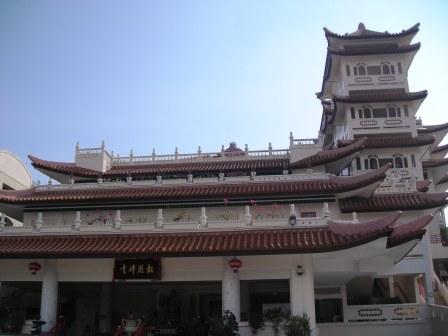 Poh Ern Shih, 九华山报恩寺 Poh Ern Shih, 九华山报恩寺
Temple of Thanksgiving
On 13 February 1942, as part of the Japanese invasion of Singapore, the Japanese invading army began advancing towards Pasir Panjang area. Their advancement towards Chandu Hill, the site of British opium production for export to China and South East Asia, was frustrated by the Malay Regiment (800 strong) whose leader Lt. Adnan bin Saidi had urged his men to fight to the end.
When the Japanese forces finally took over Pasir Panjang area on 14 February, they killed all 800 soldiers and also captured the badly injured Lt. Adnan bin Saidi who was subsequently tortured and executed. The next day, British surrendered and Singapore became Synonto until the Japanese surrender in 1945.
During the course of the Pasir Panjang campaign, many lives were lost; lives of invading Japanese and defending British soldiers and also that of innocent civilians.
In 1954, 9 years after the Japanese surrender, a Singapore Chinese philanthropist Lee Choon Seng and co-founder of OCBC bank, founded a Mahayana Buddhist monastery Poh Ern Shih, 九华山报恩寺, to liberate the spirits of war dead and dedicated the monastery to Ksitigarbha Bodhisattva.
From its beginning, Poh Ern Shih was an “innovative” monastery whose doors are open to people regardless of their ethnicity, nationality, religion and gender.
Poh Ern Shih’s first Abbot was an American Theravada monk, Venerable Sumangalo who was invited to be honorary abbot of Poh Ern Shih in 1959 making him the first Caucasian Abbot of a Buddhist monastery in Singapore who spread Buddhism to the English educated students of the then Singapore University.
In the same year, Venerable Sumangalo and a Chinese lady Buddhist pioneer, Pitt Chin Hui, translated the Ksitigarbha Bodhisattva Sutra from Chinese to English to facilitate the English speaking devotees.
In 2003, almost half a century after it’s founding, the Honorary President/Director of Poh Ern Shih, Lee Boon Siong, grandson of Lee Choon Seng, initiated an ambitious restoration plan for the monastery.
The restoration incorporates many Green Features to address contemporary concerns over the environment and management of natural resources by installing eg. solar panels and is designed to collect rain water and to facilitate access for the elderly devotees.
Meanwhile architect Lee Coo, Co author of “Buddhist architecture in Singapore”, designed the layout of the temple taking into consideration Lee boon Siong’s requirements and the hilly layout of the terrain.
By 2008, the second phase of the temple was completed and work continues.
Meanwhile, Poh Ern Shih is open to the public and has attracted many devotees, expatriate groups, local visitors and tourists. Many Singaporeans have visited Poh Ern Shih for inspiration to design an elderly friendly house while environmental groups have also visited to gain insights from the temple’s green features.
Nanyin at Poh Erh Shih
Poh Ern Shih, 九华山报恩寺
Temple of Thanksgiving
Address:
9 Chwee Chian Road
Singapore 117488
Tel: 6474 3926
Fax: 6473 7098
Website: www.pohernshih.org |
Related Articles:


|

 Ksitigarbha Bodhisattva
Ksitigarbha Bodhisattva




 Poh Ern Shih, 九华山报恩寺
Poh Ern Shih, 九华山报恩寺